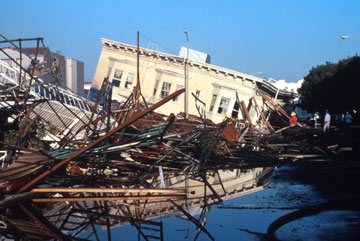|
NEWS NOTES
Earthquakes
Loma Prieta not from a weak fault?
 USGS, C.E. Meyer |
The 1989 Loma Prieta earthquake was the San Francisco Bay Area’s worst quake since 1906, causing billions of dollars of damage. New research suggests the fault was not weak as is typically thought. |
Although you may not remember who won the 1989 World Series (the Oakland A’s swept the San Francisco Giants), you probably remember the magnitude-7.1 earthquake that interrupted Game 3 at San Francisco’s Candlestick Park. Many researchers have since determined the earthquake was from the rupture of an unusually weak fault in the San Andreas Fault Zone. But a new study of the quake’s aftershocks runs counter to this orthodoxy, suggesting the fault was of normal strength. If that’s the case, then it may have implications for how scientists model seismic activity in the region, the study’s authors say.
Causing billions of dollars of damage, the Loma Prieta earthquake was Northern California’s largest earthquake since the 1906 San Francisco earthquake, garnering much scientific attention. The fault that caused the Loma Prieta earthquake gained its “weak” reputation mainly from studies of the quake’s aftershocks. A weak fault responds to stress, the forces acting on the fault, differently than a strong fault: It will rupture and cause an earthquake in response to smaller sliding stresses than a strong fault. In the past, researchers have done “inversion analyses” of the aftershocks, using the slip patterns to estimate the distribution of stress, which then is used to figure out whether the fault is weak or strong. In the case of the Loma Prieta event, these inversion analyses indicated that the maximum principal stress was acting almost perpendicular to the fault, which results in a small sliding stress on the fault. This led many to conclude that it is weak. A few researchers, however, have maintained that the analyses are incorrect and that the fault is strong.
Recently, geologist Robert Twiss of the University of California at Davis and geologist Jeffrey Unruh of the earth science consulting firm William Lettis and Associates in Walnut Creek, Calif., added to the debate by looking more closely at the aftershocks. “The results of our investigation of aftershocks are contrary to what earlier investigations concluded,” Twiss says.
Twiss and Unruh approached studying the aftershocks from a slightly different perspective than previous researchers. Instead of the usual interpretation of the results of inversion analyses as stress, Twiss says it’s more straightforward to interpret them as strain. Stress relates to the forces acting on a fault, whereas strain describes the resulting changes in the shape of bodies of rock near a fault due to stress, much like how a spring changes in length when a force acts on it. Because inversion analyses primarily define strain, he says, interpreting them as stress requires basic assumptions about how stress and strain are related, which may not hold up in this case.
To do their own inversion analysis, Twiss and Unruh created a 3-D picture of the aftershocks’ slip patterns, and noticed they could separate the more than 1,000 aftershocks into 17 spatial clusters, as they reported in September/October’s GSA Bulletin. So instead of doing one inversion analysis of all of the aftershocks grouped together, as is typically done, Twiss and Unruh considered the spatial clusters separately to determine the distribution of strain across the fault zone. “The results of the distribution of strain were most compatible with a fault that has a normal strength for crustal rock,” says Twiss, who was surprised by the findings.
Christopher H. Scholz, a specialist in earthquake physics at Columbia University in New York who has been advocating the strong fault position for years, is not surprised. “They did a terrific job,” he says. “The really took that earthquake apart.” Classifying the aftershocks into groups makes a big difference in how the data are interpreted. It’s only valid to consider all of the aftershocks together if the stress field is homogenous, and that’s not true for the Loma Prieta earthquake, Scholz says. Twiss agrees: You lose detail when you group all of the aftershocks together, and then the fault appears weak, he says.
But not everyone is ready to call this a strong fault. “I don’t agree with the study’s conclusions,” says geophysicist Mark Zoback of Stanford University in Palo Alto, Calif. Zoback, along with his Stanford colleague Greg Beroza, has done inversion analyses of the Loma Prieta aftershocks, which he says show the fault is weak. He disagrees with Twiss and Unruh’s caveats about interpreting the results of such analyses as stress. “The fundamentals of the technique are well-established,” he says, and have successfully explained earthquakes around the world for more than 50 years. Given conventional fault mechanics, Zoback says, a weak fault is the only way to explain the complex slip patterns associated with the Loma Prieta earthquake and its aftershocks.
Twiss says that this paper was never meant to provide the definitive answer to this question: It’s just another contribution to the ongoing scientific discussion, he says. But he hopes it will cause people who are trying to understand the debate to re-evaluate the weak fault hypothesis, especially as it may affect the way researchers model seismic activity in the region. “Unfortunately, this is not going to … solve the controversy,” Scholz says, but “I hope they stimulate other people to look at data in such detail.”

 Subscribe
Subscribe


